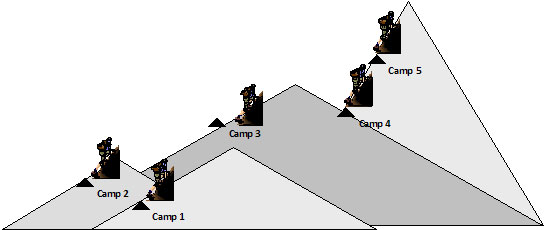1.1.4 How To Develop A Strategic Marketing Plan - WHERE
In the previous article - How To Develop A Strategic Marketing Plan - NOW, it was explained that a Strategic Marketing Plan - or Commercial Plan - consists of five components:
- Activities - now and in the future
- Markets served - now and in the future
- Products/Services provided - now and in the future
- Competitive Strategy
- Competitive Advantage
The previous article addressed the first stage of the strategic planning process - NOW.
This one looks at the second stage - WHERE.

By the time the NOW component - the situation analysis - has been completed, the planners should have a good understanding of the factors that will shape the five components of the Strategic Marketing Plan. They will understand:
- The potential impact of the key factors in the macro-external environment and the chances of their occurrence
- The potential impact of the key factors in the micro-external environment and the chances of occurrence
- The company’s own performance, primarily from its customers’ perspective
Armed with this knowledge, one can then consider the implications of these factors on the company’s medium and long-term future. And whilst the definition of long-term will depend on the market that you are in, five years is a good average.
Specifically, the planners will identify the Activities, the Markets and the Products and Services that the company will provide - the first three components of the Strategic Marketing Plan.
When considering the WHERE component of the business plan, the first thing that needs to be done is to define such words as “Objective”, “Goal” and “Strategy”.
What’s an Objective?
For an “Objective” to be regarded as such, it must be a SMART one - that is, it must be Specific, Measurable, Achievable, a Result and Time-related. Most objectives I come across do not conform to these five criteria, the most common shortcoming being that the “Objective” is an activity, not a Result.
“We will improve the level of customer service” is merely an activity and expressed in these vague terms, it would be impossible to know when it had been achieved or to monitor progress towards its achievement.
What’s a Goal?
A goal is the ultimate objective - to land a man on the moon, to reach the summit of Everest, to reach a Trading Profit of $10 million. It also conforms to the SMART criteria. Since there will be many subsidiary objectives to be achieved on the way towards the goal, the goal becomes the summit and the objectives the intermediate camps along the way.

What’s a Strategy?
A strategy is the means by which an objective is achieved. It is the HOW component of the business plan. The problem is that “One man’s strategy is another man’s objective”.
Let’s suppose that your company has as its goal a doubling of profit by the completion of the fifth year of the Five-Year Plan. This is clearly a Result.
One strategy for achieving this result might be to increase revenue by 75% over the same period. This is an Activity.
However, the Sales Manager would convert this strategy into one or more objectives. One objective might read - “to increase exports by 150% over the next five years”. That’s a Result.
In turn, this objective might generate a number of strategies such as the development of new products or establishing an alliance with a local distributor in each of the target markets. These are all activities.
The New Product Development Manager would then take the former strategy and turn that into an objective together with the strategies to achieve it.
In short, if it’s a Result, it’s an Objective; if it’s an Activity, it’s a Strategy.
In a sentence that combines both an objective and a strategy, the Objective always comes first and the Strategy is always preceded by the word “by”.
Thus by sticking with these precise definitions of “goal”, “objective” and “strategy”, every objective and strategy is aligned behind the achievement of the goal.
Developing the Goal
It is highly desirable that the goal should not only be a SMART one, but one to which everyone of your staff can relate - and one which they feel they can influence. The measure that best meets these criteria is a revenue goal.
This does mean to say that other goals are not calculated but cash flows, profitability, or Return on Investment goals should not be given the same prominence as revenue. Having more than one goal creates confusion - just as a mountain with five summits would - and everyone understands sales revenue.
Read a related article - Prospecting for new business
The final statement of WHERE might look like this:
| Taking into account the impact of the external and internal environments, the SMART goal that we have set ourselves is: _____________ | |
| The goal is made up of the following goods and services: | |
| Market penetration - selling existing products to existing customers: | _________ |
| Product development - new products to existing customers: | _________ |
| Market development: | |
| - existing products to new markets | _________ |
- new market segments |
_________ |
| - new geographical markets | _________ |
| Diversification - new products and new markets | _________ |
| Inorganic growth: | |
| - vertical integration | _________ |
| - networks, alliances, mergers, acquisitions | _________ |
| Grand Total: | _________ |
The Goal and its make-up will need to be calculated for each year of the time period that the Strategic Marketing Plan covers. Breaking down the goal by year and by sales acts as a further reality check.
Go to the next article in this series - How To Develop A Strategic Marketing Plan - HOW - Part 1






